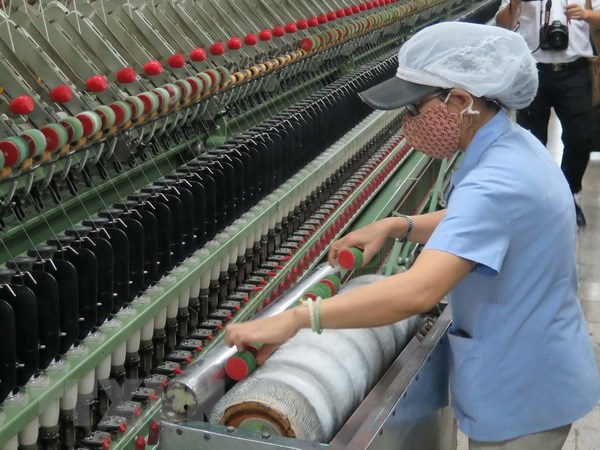
Vietnam's industrial production index (IPI) was estimated to rise 9.4 percent year-on-year in April, pushing the four-month index growth by 11.4 percent, higher than a 6.6 percent increase in the same period last year.
Vietnam’s industrial production index (IPI) was estimated to rise 9.4 percent year-on-year in April, pushing the four-month index growth by 11.4 percent, higher than a 6.6 percent increase in the same period last year.
According to the General Statistics Office, in the January-April period, the manufacturing and processing sector, which accounts for 90 percent of the industrial value, saw the strongest growth, standing at 14 percent.
Meanwhile, electricity production and distribution increased 9.7 percent, and water supply and wastewater treatment went up 5.5 percent. Only the mining sector suffered a slight decrease of 1.2 percent.
In the period, high production growth was reported in the fields of electronics, computers and optical products (26.6 percent); metal (16.3 percent); products made from precast metal (except machinery and equipment) (15.2 percent); and furniture production (14.9 percent).
Surges were also recorded in major industrial products such as iron and steel (38.2 percent), fabric (26.2 percent), powdered milk (20.7 percent), feed for aquaculture (19 percent), television (17.5 percent), and processed aquatic products (11.8 percent).
The northern province of Bac Ninh led the nation with IPI growth of 33.4 percent, followed by Hai Phong (24 percent), Vinh Phuc (13.5 percent), Thai Nguyen (12.1 percent), Hai Duong (10.7 percent), Hanoi and Dong Nai (8.1 percent), Da Nang (8 percent), Binh Duong (7.9 percent), Can Tho (7.3 percent), Quang Ninh (6.5 percent), and Ho Chi Minh City (6.1 percent).
As of April 1, the number of workers in industrial enterprises increased 3.9 percent compared to the same period last year. The number of workers in State-owned enterprises dropped 1.1 percent while those in non-State and foreign-invested businesses went up 4.3 percent and 4.5 percent, respectively.
The number of workers in provinces and cities with large-scale industry also saw increases, such as Can Tho (22.9 percent), Hai Phong (16.3 percent), Bac Ninh (13.6 percent), Thai Nguyen (7.9 percent), Binh Duong (6.8 percent), Dong Nai (5.3 percent), and Ho Chi Minh City (0.4 percent).
According to the General Statistics Office, in the January-April period, the manufacturing and processing sector, which accounts for 90 percent of the industrial value, saw the strongest growth, standing at 14 percent.
 |
| Illustrative image (Source: VNA) |
Meanwhile, electricity production and distribution increased 9.7 percent, and water supply and wastewater treatment went up 5.5 percent. Only the mining sector suffered a slight decrease of 1.2 percent.
In the period, high production growth was reported in the fields of electronics, computers and optical products (26.6 percent); metal (16.3 percent); products made from precast metal (except machinery and equipment) (15.2 percent); and furniture production (14.9 percent).
Surges were also recorded in major industrial products such as iron and steel (38.2 percent), fabric (26.2 percent), powdered milk (20.7 percent), feed for aquaculture (19 percent), television (17.5 percent), and processed aquatic products (11.8 percent).
The northern province of Bac Ninh led the nation with IPI growth of 33.4 percent, followed by Hai Phong (24 percent), Vinh Phuc (13.5 percent), Thai Nguyen (12.1 percent), Hai Duong (10.7 percent), Hanoi and Dong Nai (8.1 percent), Da Nang (8 percent), Binh Duong (7.9 percent), Can Tho (7.3 percent), Quang Ninh (6.5 percent), and Ho Chi Minh City (6.1 percent).
As of April 1, the number of workers in industrial enterprises increased 3.9 percent compared to the same period last year. The number of workers in State-owned enterprises dropped 1.1 percent while those in non-State and foreign-invested businesses went up 4.3 percent and 4.5 percent, respectively.
The number of workers in provinces and cities with large-scale industry also saw increases, such as Can Tho (22.9 percent), Hai Phong (16.3 percent), Bac Ninh (13.6 percent), Thai Nguyen (7.9 percent), Binh Duong (6.8 percent), Dong Nai (5.3 percent), and Ho Chi Minh City (0.4 percent).
(Source:VNA)





